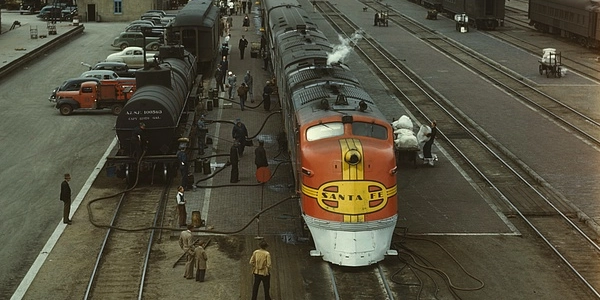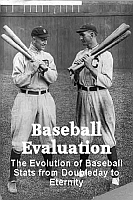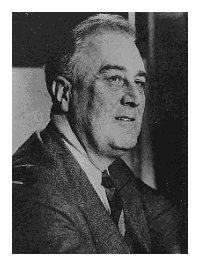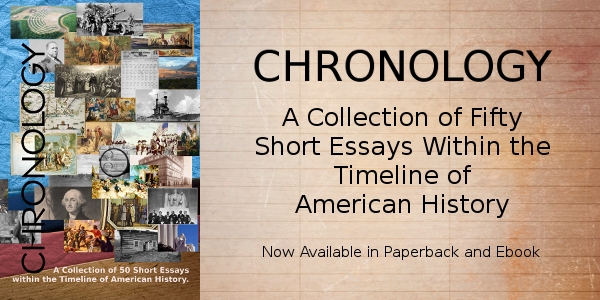Sponsor this page. Your banner or text ad can fill the space above.
Click here to Sponsor the page and how to reserve your ad.
-
Timeline
1936 - Detail
May 12, 1936 - The Santa Fe Railroad inaugurates the all-Pullman Super Chief passenger train service between Chicago, Illinois and Los Angeles, California.

George Pullman had been building his palace train cars in his Pullman factory town in Chicago since May 26, 1880. These exceedingly luxurious train cars had been the rage for over fifty years with the Pullman Porters on staff to give into every whim of the passengers who would ride these cars on various train company tracks, predominantly on shorters runs in the midwest and east. Yet it was somewhat surprising that its routes had not blazed as far west, to the growing cities along the Pacific Ocean. That is until the Santa Fe Railroad decided that these Pullman sleeping cars which made long distance train travel more tolerable could make a profit all the way to Los Angeles, despite the competition from automobiles and plane travel.
The sleeping car had been around since 1866 when the W.T. Woodruff Company started building their Palace Cars; twenty-one by 1870. The demand for new rail lines was heavy after the devastation of the Civil War, which ended in 1865. Other companies would pop up, become consolidated, and often included George Pullman as one of its investors. The Erie and Atlantic Coast Sleeping Car Company began in 1865; Pullman bought a 67% interest in it by 1872, 100% by 1888, and now controlled the Palace Car market from New York to Chicago. He bought interests in companies in the south as well, and the west. The Pullman Pacific Car Company was formed to put sleeping cars on the Union Pacific Railroad in 1868. By 1870, George Pullman had a ninety-nine year lease for the Central Transportation Company.
Consolidation to the west occured in 1883, when the Central Pacific signed with Pullman; transcontinental sleeping car-car service was now in house. By the time the Santa Fe Super Chief was plying the rails from Chicago to Los Angeles with the all-Pullman passenger train, George Pullman was long gone. The company was controlled by C.A. Liddle.

Santa Fe Railroad History
While the Santa Fe Railroad, known to some as the Atchison, Topeka, and Santa Fe, at first took a back seat to the Union Pacific and Central Pacific, due to Abraham Lincoln's desire to have a transcontinental line for after the Civil War, and the Promotory Point golden spike of 1869, which achieved that goal, it, too, was putting together a transcontinental line, which began in 1863, after their initial charter in 1859, and became the transcontinental railway of the north in 1867, two years before the government's funded line to San Francisco. The Santa Fe was predominantly a privately funded railroad. It followed an initial path from the industrial towns of the northest, through the heartland, and to the west coast.
Since the Pacific line was government run, it had its deficiencies. First, they did not know what to do with it or how to make it a paying proposition. They had not built a network of freight and passenger traffic prior to completion, or feeder lines to bring in that traffic. It was also run through Chicago, which guaranteed bad weather. For the Santa Fe, they chose their routes wisely, ones that had towns that would grow after completion. In fact, in many places they built the towns with the railroad depot smack dab in the middle of it; Albuquerque and El Paso for two.
Their visionary was Colonel Cyrus K. Holliday, who wanted to build a railroad from Kansas to the west coast and down to the Gulf of Mexico. He wanted to take advantage of the trade on the Santa Fe Trail, as well as that in the deepwater ports of the Gulf. He would hire a manager, a true professional, William Barstow Strong, who believed in expanding track. He built west from Kansas, reaching back east to Chicago in 1886. Their ultimate western goal was not San Francisco, it was Los Angeles where they landed in 1867. There was competition there; with another line running to San Francisco from Los Angeles before heading east to Chicago. That competition drove down prices from $125 to $1 for a one way ticket.
All of these passenger heading to Los Angeles made the city a boom town without a gold mine cause. From eleven thousand in population in 1880, it grew to fifty thousand by the 1890 census. It had sunshine, beaches, and good weather all year long. It was said that the Santa Fe made Los Angeles and Los Angeles made the Santa Fe. While Chicago did not have any of those amenities, it also doubled in population during the 1880 decade. Montgomery Ward headquartered its catalog business there, and began selling its ten thousand catalog goods through the train network. The chain restaurant began; Harvey House restaurants were built every one hundred miles along the track. The lure of sunshine year round also drew the film industry as David Horsley, Cecil B. DeMille, and D.W. Griffith came west.
The Panic of 1893 caused the Santa Fe Railroad and Strong to be monetarily challenged due to his expanding track philosophy, but the rode through the decade, like many businessmen of that era, and unlike some, came out on the other side with a prosperous company again. Even when the depression hit in 1929, the Santa Fe Railroad did not falter.
The Super Chief
The introduction of the Super Chief streamliner gained the Santa Fe new acclaim. Not only did it have the finest all-Pullman sleeper cars, but its sleek design, homage to the Native Americans, and Art Deco design made it stand out from its dimmer cousins. It was built to be durable with heavyweight cars powered by two Electro-Motive diesels nicknamed Amos and Andy. And it was fast, going from Chicago to Los Angeles in a blistering thirty-nine hours and forty-five minutes. This was much faster than its competition.
By 1930, the Santa Fe Railroad had thirteen thousand two hundred and thirty-one miles of track. Its principal lines were ... Chicago to Kansas City to La Junta, Colorado, to Los Angeles; Emporia, Kansas, to Oklahoma City to Fort Worth to Houston; Emporia, Kansas, to Dalies, New Mexico; Barstow to Richmond, California (the Valley Division); Temple to Farwell, Texas; Denver to La Junta, Colorado; Albuquerque, New Mexico, to El Paso, Texas; Dallas to Presidio, Texas; and Kansas City to Tulsa.
In 1996, the railroad merged with Burlington Northern and is now known as the Burlington Northern and Santa Fe Railroad.
Photo above: Santa Fe Railroad Super Chief being service in Albuquerque, New Mexico, 1943, Jack Delano. Courtesy Library of Congress. Courtesy of Library of Congress. Photo Below: Pullman Palace Car Company Administration Building, date and author unknown. Courtesy National Park Service via the Chicago Public Library. Info Source: Wikipedia Commons; "A Pullman Timeline," 2022, Frank H. Berberdick; "How the Santa Fe Railroad Changed America Forever," 2021, John Sedgwick, Smithsonian Magazine; "Santa Fe Railroad: Map, Logo, History, Roster," 2024, Adam Burns, american-rails.com.

The sleeping car had been around since 1866 when the W.T. Woodruff Company started building their Palace Cars; twenty-one by 1870. The demand for new rail lines was heavy after the devastation of the Civil War, which ended in 1865. Other companies would pop up, become consolidated, and often included George Pullman as one of its investors. The Erie and Atlantic Coast Sleeping Car Company began in 1865; Pullman bought a 67% interest in it by 1872, 100% by 1888, and now controlled the Palace Car market from New York to Chicago. He bought interests in companies in the south as well, and the west. The Pullman Pacific Car Company was formed to put sleeping cars on the Union Pacific Railroad in 1868. By 1870, George Pullman had a ninety-nine year lease for the Central Transportation Company.
Consolidation to the west occured in 1883, when the Central Pacific signed with Pullman; transcontinental sleeping car-car service was now in house. By the time the Santa Fe Super Chief was plying the rails from Chicago to Los Angeles with the all-Pullman passenger train, George Pullman was long gone. The company was controlled by C.A. Liddle.

Since the Pacific line was government run, it had its deficiencies. First, they did not know what to do with it or how to make it a paying proposition. They had not built a network of freight and passenger traffic prior to completion, or feeder lines to bring in that traffic. It was also run through Chicago, which guaranteed bad weather. For the Santa Fe, they chose their routes wisely, ones that had towns that would grow after completion. In fact, in many places they built the towns with the railroad depot smack dab in the middle of it; Albuquerque and El Paso for two.
Their visionary was Colonel Cyrus K. Holliday, who wanted to build a railroad from Kansas to the west coast and down to the Gulf of Mexico. He wanted to take advantage of the trade on the Santa Fe Trail, as well as that in the deepwater ports of the Gulf. He would hire a manager, a true professional, William Barstow Strong, who believed in expanding track. He built west from Kansas, reaching back east to Chicago in 1886. Their ultimate western goal was not San Francisco, it was Los Angeles where they landed in 1867. There was competition there; with another line running to San Francisco from Los Angeles before heading east to Chicago. That competition drove down prices from $125 to $1 for a one way ticket.
All of these passenger heading to Los Angeles made the city a boom town without a gold mine cause. From eleven thousand in population in 1880, it grew to fifty thousand by the 1890 census. It had sunshine, beaches, and good weather all year long. It was said that the Santa Fe made Los Angeles and Los Angeles made the Santa Fe. While Chicago did not have any of those amenities, it also doubled in population during the 1880 decade. Montgomery Ward headquartered its catalog business there, and began selling its ten thousand catalog goods through the train network. The chain restaurant began; Harvey House restaurants were built every one hundred miles along the track. The lure of sunshine year round also drew the film industry as David Horsley, Cecil B. DeMille, and D.W. Griffith came west.
The Panic of 1893 caused the Santa Fe Railroad and Strong to be monetarily challenged due to his expanding track philosophy, but the rode through the decade, like many businessmen of that era, and unlike some, came out on the other side with a prosperous company again. Even when the depression hit in 1929, the Santa Fe Railroad did not falter.
By 1930, the Santa Fe Railroad had thirteen thousand two hundred and thirty-one miles of track. Its principal lines were ... Chicago to Kansas City to La Junta, Colorado, to Los Angeles; Emporia, Kansas, to Oklahoma City to Fort Worth to Houston; Emporia, Kansas, to Dalies, New Mexico; Barstow to Richmond, California (the Valley Division); Temple to Farwell, Texas; Denver to La Junta, Colorado; Albuquerque, New Mexico, to El Paso, Texas; Dallas to Presidio, Texas; and Kansas City to Tulsa.
In 1996, the railroad merged with Burlington Northern and is now known as the Burlington Northern and Santa Fe Railroad.
Photo above: Santa Fe Railroad Super Chief being service in Albuquerque, New Mexico, 1943, Jack Delano. Courtesy Library of Congress. Courtesy of Library of Congress. Photo Below: Pullman Palace Car Company Administration Building, date and author unknown. Courtesy National Park Service via the Chicago Public Library. Info Source: Wikipedia Commons; "A Pullman Timeline," 2022, Frank H. Berberdick; "How the Santa Fe Railroad Changed America Forever," 2021, John Sedgwick, Smithsonian Magazine; "Santa Fe Railroad: Map, Logo, History, Roster," 2024, Adam Burns, american-rails.com.








